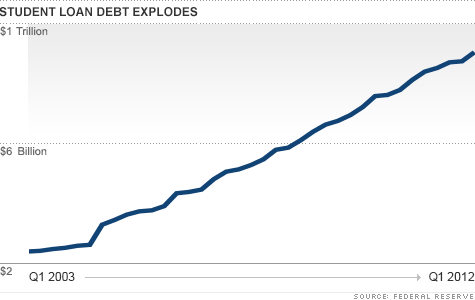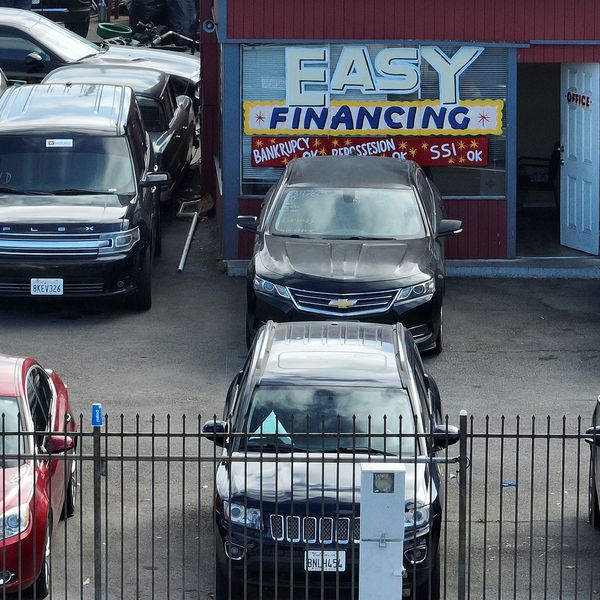Student Loan Debt Explodes, Climbing 275% Since 2003
New data released today by the Federal Reserve shows, while general consumer debt has decreased in the first quarter of this year, student loan debt in particular continues to aggressively increase. Overall student loan debt has skyrocketed in the past 10 years, rising by 275%.
According to the Federal Reserve, student loan debt hit $904 billion in the first quarter of 2012; however, the Consumer Financial Protection Bureau puts the number at the $1 trillion mark.
"While consumers have been whittling down that debt in recent years, student loans have been on the rise. The high unemployment rate has prompted more people to go back to school for retraining, which has contributed to loan demand," reports Reuters today. "Since household debt peaked in the third quarter of 2008, student loan debt has climbed by $293 billion, while other types of debt have dropped by $1.53 trillion, the Fed report said."
Others lay some of the blame on the continually increasing costs of education, as college tuition and fees continue to reach new levels.
* * *

* * *
CNN: Fed: Student loans soar 275% over past decade
Student loans have more than tripled over the past decade, according to new data from the Federal Reserve.
Student loan debt hit $904 billion in the first quarter of 2012, up from $241 billion a decade ago, according to the Federal Reserve Bank of New York quarterly household debt report. That's up 275% since the same period in 2003. [...]
Since that peak, student loan debt has shot up $293 billion, while other debts fell a combined $1.53 trillion. Student loans have been the second highest form of consumer debt since the second quarter of 2010, behind mortgages.
Americans are also increasingly falling behind on their student loans. Long-term delinquency rates now stand at 8.69%, up from 6.13% a decade ago.
That's higher than the delinquency rates of mortgages, auto loans and home equity lines of credit, but still down from a peak of 9.17% in the third quarter of 2010. [...]
Borrowing is also up as the cost of college rises. Some 90% of new student lending comes from the federal government, and the amount undergraduates can borrow is generally capped at $31,000.
* * *
Reuters: US consumer debt eases, but student loans rise
During the year leading up to the end of March, student loan balances rose $64 billion, while all other forms of household debt fell a combined $383 billion.
"Student loan debt continues to grow even as consumers reduce mortgage debt and credit card balances," Donghoon Lee, senior economist at the New York Fed, said in a statement.
"It remains the only form of consumer debt to substantially increase since the peak of household debt in late 2008." [...]
Since household debt peaked in the third quarter of 2008, student loan debt has climbed by $293 billion, while other types of debt have dropped by $1.53 trillion, the Fed report said. [...]
Student loan debt has also become a theme in the U.S. presidential election as lawmakers consider how to prevent interest rates on loans from doubling to 6.8 percent.
# # #
An Urgent Message From Our Co-Founder
Dear Common Dreams reader, The U.S. is on a fast track to authoritarianism like nothing I've ever seen. Meanwhile, corporate news outlets are utterly capitulating to Trump, twisting their coverage to avoid drawing his ire while lining up to stuff cash in his pockets. That's why I believe that Common Dreams is doing the best and most consequential reporting that we've ever done. Our small but mighty team is a progressive reporting powerhouse, covering the news every day that the corporate media never will. Our mission has always been simple: To inform. To inspire. And to ignite change for the common good. Now here's the key piece that I want all our readers to understand: None of this would be possible without your financial support. That's not just some fundraising cliche. It's the absolute and literal truth. We don't accept corporate advertising and never will. We don't have a paywall because we don't think people should be blocked from critical news based on their ability to pay. Everything we do is funded by the donations of readers like you. Will you donate now to help power the nonprofit, independent reporting of Common Dreams? Thank you for being a vital member of our community. Together, we can keep independent journalism alive when it’s needed most. - Craig Brown, Co-founder |
New data released today by the Federal Reserve shows, while general consumer debt has decreased in the first quarter of this year, student loan debt in particular continues to aggressively increase. Overall student loan debt has skyrocketed in the past 10 years, rising by 275%.
According to the Federal Reserve, student loan debt hit $904 billion in the first quarter of 2012; however, the Consumer Financial Protection Bureau puts the number at the $1 trillion mark.
"While consumers have been whittling down that debt in recent years, student loans have been on the rise. The high unemployment rate has prompted more people to go back to school for retraining, which has contributed to loan demand," reports Reuters today. "Since household debt peaked in the third quarter of 2008, student loan debt has climbed by $293 billion, while other types of debt have dropped by $1.53 trillion, the Fed report said."
Others lay some of the blame on the continually increasing costs of education, as college tuition and fees continue to reach new levels.
* * *

* * *
CNN: Fed: Student loans soar 275% over past decade
Student loans have more than tripled over the past decade, according to new data from the Federal Reserve.
Student loan debt hit $904 billion in the first quarter of 2012, up from $241 billion a decade ago, according to the Federal Reserve Bank of New York quarterly household debt report. That's up 275% since the same period in 2003. [...]
Since that peak, student loan debt has shot up $293 billion, while other debts fell a combined $1.53 trillion. Student loans have been the second highest form of consumer debt since the second quarter of 2010, behind mortgages.
Americans are also increasingly falling behind on their student loans. Long-term delinquency rates now stand at 8.69%, up from 6.13% a decade ago.
That's higher than the delinquency rates of mortgages, auto loans and home equity lines of credit, but still down from a peak of 9.17% in the third quarter of 2010. [...]
Borrowing is also up as the cost of college rises. Some 90% of new student lending comes from the federal government, and the amount undergraduates can borrow is generally capped at $31,000.
* * *
Reuters: US consumer debt eases, but student loans rise
During the year leading up to the end of March, student loan balances rose $64 billion, while all other forms of household debt fell a combined $383 billion.
"Student loan debt continues to grow even as consumers reduce mortgage debt and credit card balances," Donghoon Lee, senior economist at the New York Fed, said in a statement.
"It remains the only form of consumer debt to substantially increase since the peak of household debt in late 2008." [...]
Since household debt peaked in the third quarter of 2008, student loan debt has climbed by $293 billion, while other types of debt have dropped by $1.53 trillion, the Fed report said. [...]
Student loan debt has also become a theme in the U.S. presidential election as lawmakers consider how to prevent interest rates on loans from doubling to 6.8 percent.
# # #
New data released today by the Federal Reserve shows, while general consumer debt has decreased in the first quarter of this year, student loan debt in particular continues to aggressively increase. Overall student loan debt has skyrocketed in the past 10 years, rising by 275%.
According to the Federal Reserve, student loan debt hit $904 billion in the first quarter of 2012; however, the Consumer Financial Protection Bureau puts the number at the $1 trillion mark.
"While consumers have been whittling down that debt in recent years, student loans have been on the rise. The high unemployment rate has prompted more people to go back to school for retraining, which has contributed to loan demand," reports Reuters today. "Since household debt peaked in the third quarter of 2008, student loan debt has climbed by $293 billion, while other types of debt have dropped by $1.53 trillion, the Fed report said."
Others lay some of the blame on the continually increasing costs of education, as college tuition and fees continue to reach new levels.
* * *

* * *
CNN: Fed: Student loans soar 275% over past decade
Student loans have more than tripled over the past decade, according to new data from the Federal Reserve.
Student loan debt hit $904 billion in the first quarter of 2012, up from $241 billion a decade ago, according to the Federal Reserve Bank of New York quarterly household debt report. That's up 275% since the same period in 2003. [...]
Since that peak, student loan debt has shot up $293 billion, while other debts fell a combined $1.53 trillion. Student loans have been the second highest form of consumer debt since the second quarter of 2010, behind mortgages.
Americans are also increasingly falling behind on their student loans. Long-term delinquency rates now stand at 8.69%, up from 6.13% a decade ago.
That's higher than the delinquency rates of mortgages, auto loans and home equity lines of credit, but still down from a peak of 9.17% in the third quarter of 2010. [...]
Borrowing is also up as the cost of college rises. Some 90% of new student lending comes from the federal government, and the amount undergraduates can borrow is generally capped at $31,000.
* * *
Reuters: US consumer debt eases, but student loans rise
During the year leading up to the end of March, student loan balances rose $64 billion, while all other forms of household debt fell a combined $383 billion.
"Student loan debt continues to grow even as consumers reduce mortgage debt and credit card balances," Donghoon Lee, senior economist at the New York Fed, said in a statement.
"It remains the only form of consumer debt to substantially increase since the peak of household debt in late 2008." [...]
Since household debt peaked in the third quarter of 2008, student loan debt has climbed by $293 billion, while other types of debt have dropped by $1.53 trillion, the Fed report said. [...]
Student loan debt has also become a theme in the U.S. presidential election as lawmakers consider how to prevent interest rates on loans from doubling to 6.8 percent.
# # #

